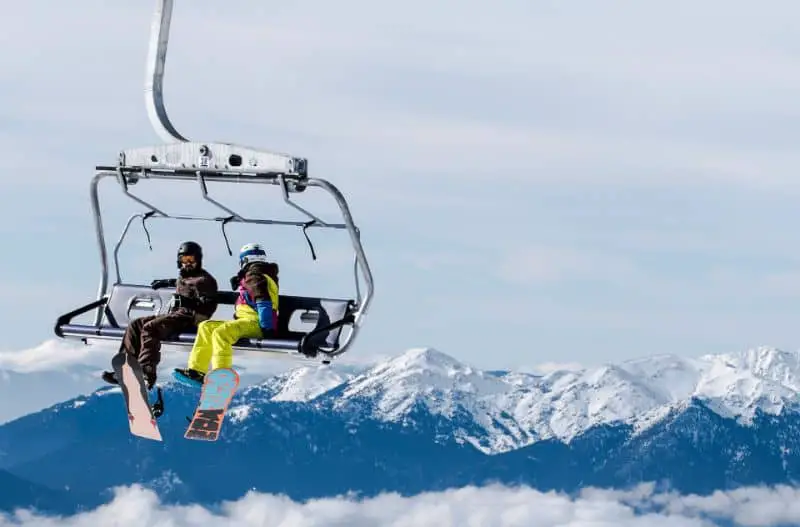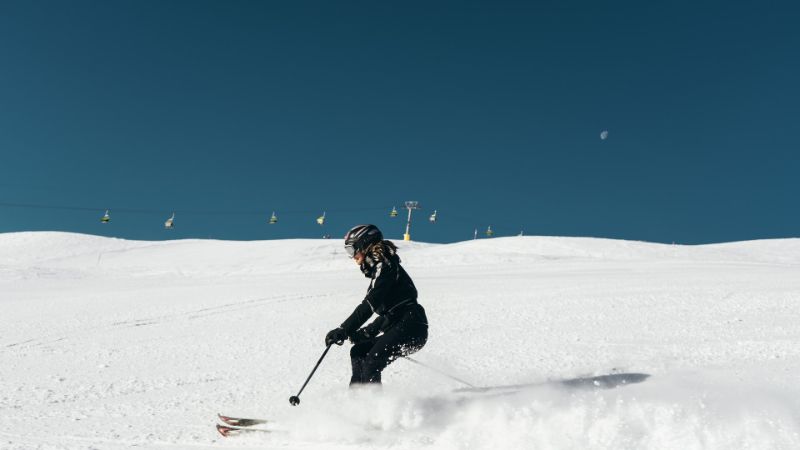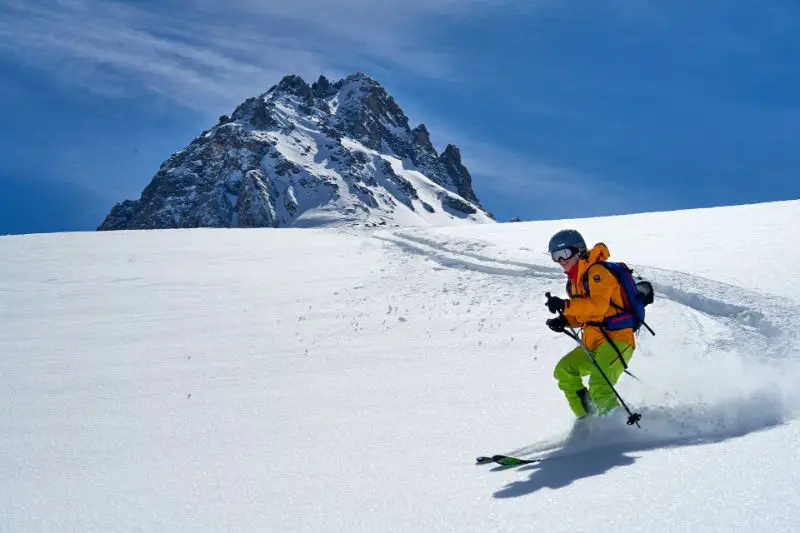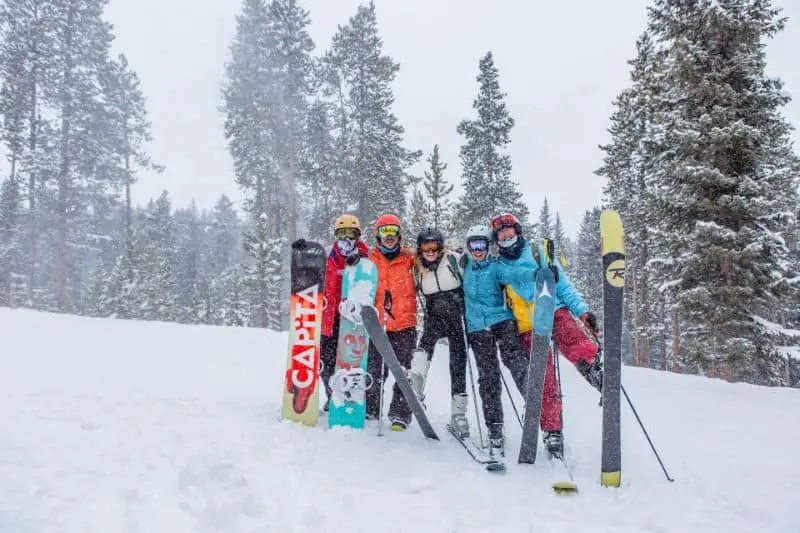I took up skiing, and three days later, I skied my first black diamond. I credit my success to two reasons: One, I roller-skated and skate-boarded a lot in high school, so I was familiar with the overall body movements. Secondly, I voraciously consumed YouTube tutorials, several of which I’ll link to in the article below.
Here’s what I’ve learned several seasons since. Powder to the people!
1. Watch Some Skiing Tutorials
Even if you’re paying for ski lessons, do yourself a favor and watch a few tutorials beforehand! Here are some of my favorites:
The production value of these channels is through the roof! I’ve probably watched Elate Media’s Ski tutorials a dozen times over. Highly, highly recommend!
2. Don’t Leap Off the Chairlift

Everyone’s afraid of getting off the chairlift the first time. It’s OK. And if you do fall, just ask for help.
The trick is to sit near the middle of the chair and let yourself be pushed down the slope. You don’t need to launch yourself; let gravity do the work. Bend a little at the knees and lean forward, and you’ll glide away like a rock star.
3. Wear Water-Resistant Clothing
Nothing ruins a day of skiing faster than a soggy bottom and cold hands!
The best thing to wear for your first day skiing is a pair of ski overalls and water-resistant insulated jacket. Don’t wear denim jeans or cotton hoodies. You don’t necessarily need waterproof clothing, but you don’t want to get damp and shivery after a spill.
Pro Tip: A Merino wool ski balaclava will be the best $25 you ever spent. It will keep your face warm, toasty, and not wind-burned.
4. Know the Slope Grades
The European Slope Grades are as follows:
- Green = Easy Slopes
- Blue = Beginners
- Red = Intermediate
- Black = Advanced
The US Slope Grades are as follows:
- Green (circle): Beginner
- Blue (square): Intermediate
- Black (diamond): Expert
Note that these ratings differ by resort and region. A black diamond at an easy Mid-Atlantic resort will be nowhere near as difficult or committing as a black diamond at Whistler.
Don’t go off-piste or through parks. Stick to the groomers for your first few sessions.
5. Ski Lessons Are Your Choice
Out of all the sports I’ve ever done, skiers seem the most insistent on professional lessons. I suppose that’s because it’s a rich-white-guy sport (which needs to change). In fact, most teachers recommend a full week of lessons.
And if you plan on becoming a life-long skier or trying out the competitive circuit, then yes, lessons are worth their weight in gold. Why form bad habits early?
But if you’re just going to have fun on the slopes, then don’t feel pressured. Yes, lessons are best. But you can have a great time without paying $100 extra for a 2-hr session to learn how to pizza.
6. Control Your Speed with Turns

The Number #1 thing to know about skiing is that you control your speed by turning. If you face directly down the fall line, you will accelerate very, very quickly.
But if you skid nice, large, S-shaped turns down the face, you’ll always be in control. If you’re moving faster than you’d like, just ski uphill – you’ll slow down! Don’t rush the turn; trust the turn.
This is why wide, moderate slopes are best for beginners. You’ll have all the space you need to ski sideways or uphill.
7. Learn the Kick Turn Early
Turning around on skis can be difficult. It’s like executing an 85-point turn. But if you have good balance, you can learn the kick turn on your first day! With a kick turn, you can turn completely around in just a few seconds.
8. Don’t Fear the Fall

Snow is a soft, powdery gift from God. Don’t be afraid of it. If you fall off-piste, the powder will swallow you up (just hope there isn’t a rock hiding).
If you fall on the piste, don’t freak out. Fall on your rump. Let yourself slide out and slide away. Keep the skis together and at a right angle to the slope, which will slow you down and arrest the fall.
9. Ignore the 5-Year-Olds

Young kids have no fear, no peer pressure, and not very far to fall. Ignore them. Physics is on their side. Don’t get discouraged when a 5-year-old skis past you, buttering and popping like a pro. Just remember you can stay up past 9:00 p.m., and he can’t.
10. Trust the Outside Ski
When you begin skiing parallel turns (yes, you can start as soon as you want), trust the outside ski! Don’t weight the inside ski. If you do, your tips will cross and you’ll get hopelessly tangled. Unless you’re pointing directly down the fall line, most skiing is done on one leg at a time. Commit to the turn!
11. Dress in Layers
Don’t show up in a tee shirt underneath an enormously puffy mountaineering jacket. Skiing will warm you up on the way down, and you’ll get cold on the chair lift coming back up. You need layers!
- Medium-weight water-wicking thermal underwear will keep you amazingly warm without weighing you down. In a pinch, use yoga pants.
- A polyester fleece or puffy down-filled nylon jacket makes a lightweight, soft midlayer with minor moisture- or wind-resistance.
- A rain-proof windbreaker or insulated ski jacket will keep you toasty even when night skiing on cold, cloudless, windy nights!
12. But Don’t Layer Socks or Gloves!
Layering up DOESN’T WORK with socks and gloves! The extra compression will slow down your blood circulation and MAKE YOU COLDER. If you need more warmth, invest in better, puffier gloves and socks. (I also got frostbite once because I ignored my own advice.)
13. “Flex” Forward!
The farther back you lean on your skis, the less control you have!
That’s difficult to remember when you’re looking down a cliff slope and start zooming down the fall line. But if you want to control your speed, lean a little forward and trust your edges. If you lean back, you’ll just skid out.
14. Rent Your Gear Early
You don’t need to buy ski gear – just rent it. Most ski resorts have smaller ski shops in the surrounding area with cheaper deals, especially if you need a multi-day rental.
A ski rental normally comes with:
- Skis
- Bindings
- Boots
- Poles
If you need other gear, like a helmet and goggles, you’ll need to rent those separately.
A ski shop will outfit your skis based on your weight, height, skill level, and preferred type of skiing.
Be prepared: Boots are supposed to be tight. Don’t be afraid to crank down on them. And just be thankful it’s not ballet or rock climbing.
Pro Tip: The earlier you can rent your gear, the better! Otherwise you’ll get the leftovers.
15. Consider Buying a Helmet and Ski Goggles
If you plan on skiing regularly, invest in a ski helmet and polarized goggles.
- You should buy a MIPS helmet, a brain bucket designed to keep your skull safe even in a glancing hit while rotating.
- Good goggles are essential; bad ones will fog up. They make different lenses for night skiing and day skiing; choose the one you’ll do most.
16. Trust the Side Slip

Unless you stick to the bunny slopes, you will almost certainly come to steep terrain you’re not comfortable with. You have four choices:
- “Pizza” turn across the slope
- Side-slip directly down the fall line
- Scoot down on your rump
- Retreat in shame
Everyone learns the pizza turn first, and that’s great. But on the really steep stuff, a side-slip works better. You can get down any slope with it!
17. Bring Sunscreen
A “bluebird day” can give you a worse sunburn than a July 4th vacation to Florida! Protect exposed skin (especially noses, ears, hands and necks) with sunscreen.
18. Find a Resort with a Magic Carpet
There are different types of ski lifts: chairlifts, trams, rope tows, T-bars, etc.
The easiest ski lift for a beginner is a Magic Carpet, which is basically a giant conveyor belt. You’ll find these on the practice bunny slopes. They’re great for kids.
Other easy slopes will use a rope grab. There’s a trick – make sure your skis are pointed in the direction of the rope before you grab on!
19. Do Some Squats Beforehand
Skiing requires some muscle. You’ll be partially crouched, leaning forward, knees bent. It requires core, thigh, and hip strength.
Do yourself a favor and start doing some bodyweight squats at least 2 weeks prior! (If you can’t do squats, try lunges). Your body will get used to the effort, and you won’t be so sore the day after.
20. Practice Getting Up
I suggest you “fall” on the bunny slope first. You need to learn how to get up – which is only easy if you know how to do it!
Here’s one of my favorite videos from Elate Media Ski School. He’ll show you how it’s done.
P.S. You should also practice clicking into your ski bindings while on the ground. If you take a hard fall, your ski might pop off. You need to know how to reset while on the slope.
21. Double-Check Your Insurance
Not all insurance policies cover adventure sports, especially if you’re out of the country. Double-check your coverage. If skiing isn’t covered, you can purchase gap insurance or accident/injury coverage like Spot.
22. Pack Snacks
Unless you enjoy lighting money on fire, you might want to pack your own snacks. Some granola bars and energy gels will work wonders.
Pro Tip: Bring a backup pair of thin cotton gloves for eating. You can’t eat a meal with puffy ski gloves.
23. Learn How to Stop
The best way to stop on skis is a “hockey stop.” If you’re an experienced skater, you might be able to learn this on your first day. If not, you have three other options:
- Ski uphill
- Plop over
- Pizza
Doing the pizza works well on most slopes.
24. Don’t Go in March
In early spring, freeze-thaw cycles transform the corduroy hardpack snow into wet slush, concrete, and corn snow – none of which are beginner-friendly. If you’re new to skiing, go when the piste is groomed and the power’s deep. You’ll enjoy yourself much more!
25. Stairs Are Difficult, FYI
If you have to descend or ascend stairs in your ski boots, be prepared. It’s tough the first time – you can’t flex your ankle like you’re used to. Side-step and hold on the hand railing. Don’t rush!
26. Look 10-15 Feet in Front of You

When skiing, don’t be fixated on your tips. By the time you spy a problem, it’ll be too late. Aggressive skiing is good skiing. Lead the turns, look ahead, and be proactive, not reactive. Keep your eyes on the terrain about 10-15 feet in front of you.
27. Know the Skier’s Right of Way
Downhill skiers have the right of way. Obviously, you can’t see them, but that means you should stay off slopes where you are likely to be slower than everyone else.
- Don’t carve giant turns across the slope through someone else’s line.
- Don’t stop in the middle of the slope.
- The people in front of you have the right of way. It’s your responsibility to avoid them.
And don’t hit pedestrians.
28. Be Brave, But Not Egotistical
Skiing comes in more flavors than Baskin Robbins: downhill carving, park skiing, tree skiing, big mountain, etc.
I encourage you to try out different terrains, different styles. You might find yourself called to a pair of twin tips and a jump. Or maybe to the deep powder, where big drops are king. (Personally, I love darting through thick stands of trees.)
Just don’t be stupid. You don’t want to end your first time skiing getting carried out by Ski Patrol.

